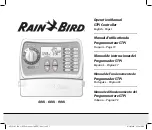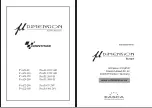
MONITOR COMPACT DIGITAL INTERCOM SIN TECLADO
SETTINGS TABLE
1 - Switch off the monitor.
2 - Put a shortcircuit wire between the te
or keep the button pressed if it exists.
rminals of the door button
3 – Switch on the monitor: the LED
the code.
starts flashing quickly waiting for
4 - Program the desired code in the dip-switch.
5 - Validate it by pressing the button of melody selection. (C)
6 – The LED turns to fixed blue and the monitor remains inactive.
7 - Switch off the monitor.
8 - Undo the shortcircuit between termi
to the desired configuration.
nals. Replace the dip-switch
It has been set.
Programming options
C ode
Function
0
No ringtones.
1
One ringtone.
2
Two ringtones.
3
Three ringtones.
4
Four ringtones
5
No ringtones on the speaker, but in the auxiliary output the
number of ringtones will be the previously programmed.
6
7
AUX output pulse type (1seg)
8
AUX output toggle type
Electronic call extension activated during the call (30seg)
TABLE 1
MONITOR / TELEPHONE STATUS
FUNCTIONING
-OFF: ON/OFF
switch in OFF position. The LED remains off.
-STAND BY:
ON/OFF switch in ON position. The blue LED remains on.
-ACTIVE:
The blue LED flashes.
CALL FROM PANEL.
The blue led flashes, the ringing tones can be heard and the screen gets activated. The communication can be cancelled pressing (
). To get
audio lift the handset up. The maximum communication time is 1m 30s and for this period the led will flash slower. If the call is not attended during the first 30s the
system will return to STAND BY mode. The door can be released at any time of the call stage pressing (
). This action will reduce the communication time to 20s.
* Secondary Monitor: In case of having a secondary monitor, it will make the ringing tones, but the screen will remain switched off until the handset is lifted or the
self-starting (
) is pressed.
SELF-STARTING.
It is possible to get video from outdoor panel at any time, pressing (
). To get audio communication, lift the handset up. The maximum length of
the conversation is 1m 30s. During the self-starting stage the door can be opened at any time pressing (
). This will reduce the communication time to 20s. This
function works only if both panel and monitor have the self-starting option activated.
If there are several panels, self-starting can scroll through all of them simply pressing (
) again. A long press returns to standby.
CALL TO SWITCHBOARD.
Lift the handset up and press (
). If there is a switchboard in the installation, this action will establish communication with it. The conversation
will last a maximum of 1m 30s.
CALL FROM SWITCHBOARD.
It works as a call from panel but in this case, the ringing tone is different and the door cannot be opened.
CALL FROM DOORBELL PUSH-BUTTON.
The ringing tone is different from the panel or the switchboard tone, and the led remains on 30 seconds in orange colour.
ESTADOS DEL MONITOR
-APAGADO:
Conmutador de ON/OFF en posición OFF. El indicador luminoso permanece apagado
-
EN ESPERA:
Conmutador de ON/OFF en posición ON. El indicador luminoso permanece encendido de color azul.
-
ACTIVO:
El indicador luminoso parpadea
el indicador luminoso,
FUNCIONAMIENTO CON PLACAS Y CONSERJERIA
LLAMADA.
Cuando el monitor recibe una llamada desde la placa, parpadea
suena el tono de aviso y se enciende la pantalla para poder
observar a la persona que la realizó.
Para establecer una comunicación de audio, descolgar el brazo telefónico, el led parpadeará más despacio. La duración máxima de la comunicación es de 1m 30s
En caso de no descolgar en 30s, cesará el tono de aviso y se apagará la pantalla.
Durante la fase de llamada se puede accionar el abre-puertas (
) en cualquier momento o rechazar la llamada pulsando (
) sín descolgar.
*Monitor secundario:
En caso de tener un monitor secundario, en éste sonará la llamada pero no aparecerá video hasta que descuelgue o pulse (
)
AUTOENCENDIDO.
Se puede activar y volver a desactivar el vídeo del monitor con la placa sin haber recibido una llamada, pulsando autoencendido (
). Para
establecer una comunicación de audio, descolgar el brazo telefónico. La duración máxima de la comunicación es de 60seg.
Durante la fase de autoencendido se puede accionar el abre-puertas (
) en cualquier momento.
Esta función solo será posible en caso de estar habilitado el autoencendido tanto en la placa de calle como en el monitor.
Si existen varias placas, el autoencendido puede desplazarse por todas ellas simplemente volviendo a pulsar
(
).
Una pulsación larga retorna a reposo.
LLAMADA A CENTRAL.
En caso de existir una central de conserjería, se podrá establecer una comunicación de audio con la misma desde el monitor, con una duración
máxima de 1m 30s. Para realizar esta función se debe descolgar el brazo telefónico y presionar el pulsador de abrepuertas/llamada a central (
).
LLAMADA DESDE CENTRAL:
Funciona igual que una llamada desde placa pero el tono de llamada es específico de conserje y no se podrá accionar el abrepuertas.
LLAMADA DESDE EL PULSADOR DE LA VIVIENDA:
Suena un tono de llamada distinto al de llamada desde la placa o central.
1- Apagar.
2- Poner un hilo de cortocircuito entre las bornas del pulsador de puerta o
presionar el pulsador si es que existe.
3- Encender: El led azul parpadea rapidamente en espera del código.
4- Programar el código deseado en el dip-switch de configuración.
5- Validar presionando el pulsador de cambio de melodías (C).
6- El led se queda en fijo en azul y se queda bloqueado.
7- Apagar.
8- Deshacer el cortocircuito entre bornas. Reponer el
dip-switch
a la configuración deseada.
Ya está programado.
TABLA 1
TABLA DE CONFIGURACIONES
(30seg)
POL. IND. EL OLIVERAL - CALLE C , NAVES 9-10 46394 RIBARROJA DEL TURIA (VALENCIA)
TFNO. +34 96 164 30 20 - FAX. +34 96 166 52 86 E-MAIL: [email protected] HTTP://WWW.AUTA.ES


























